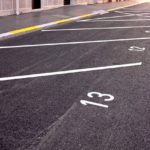parking lot striping — is it even necessary? All it is, are a few white lines indicating where people should park… right? Wrong! There is a fair bit more to parking lot striping than that. And you should be familiar with that to maximize the benefits of your parking lot striping. From initial impressions to lasting impressions, these are the top six facts about line striping you should know:
1. First impressions are lasting impressions.
 When someone enters your commercial property, your parking lot is most likely the first thing they encounter! If your parking lot striping is in good shape, visitors will notice — and they will stick around. A well-marked parking lot shows your pride in your property, which in turn demonstrates to prospective customers that they can trust you. In other words, well-maintained parking lots are more likely to convert a lead into a customer.
When someone enters your commercial property, your parking lot is most likely the first thing they encounter! If your parking lot striping is in good shape, visitors will notice — and they will stick around. A well-marked parking lot shows your pride in your property, which in turn demonstrates to prospective customers that they can trust you. In other words, well-maintained parking lots are more likely to convert a lead into a customer.
2. You need to consider special markings.
It is not just about lines, though. While considering parking lot striping, you should also consider whether particular markings or stencils are required — such as handicap parking, stop signs/speed limits, no-parking zones, or warnings. Additionally, you want to ensure that you have well-marked crosswalks.
3. Striping makes your parking lot safer.
A clearly delineated parking lot with line striping ensures the safety of your visitors.  Pedestrians will be able to identify safe walking paths and avoid walking or standing in loading zones unknowingly. Additionally, it enhances traffic flow and helps reduce vehicular accidents.
Pedestrians will be able to identify safe walking paths and avoid walking or standing in loading zones unknowingly. Additionally, it enhances traffic flow and helps reduce vehicular accidents.
For example, by using arrows to indicate entrances, exits, and directional flow, as well as clearly defined fire lanes and loading zones, you can keep traffic flowing and prevent accidents. In other words, you can minimize your risk of being held liable for any type of accident or property damage. If one vehicle swerves into another and your lines are in good condition, there is no way they can blame the accident on inadequate parking lot maintenance and absence of signage.
4. What does the process look like?
Paint is applied to a striping machine at a minimum thickness of 13 millimeters for high-quality parking lot striping. Because most of the paint will soak into the pavement, you will want to plan for multiple layers of paint. Additionally, ensure that your asphalt contractor uses durable paint and creates precise, uniform lines.
5. Prep work is key.
Prepare your parking lot for line striping ahead of time to save yourself some time and money. First of all, walk around your lot and look for any signs of damage — stripes will not last if painted over broken pavement. Schedule professional repairs before a paint job. Second, notify visitors in advance. If you have striping done during business hours, arrange alternate parking arrangements. Lastly, clean the lot. Clear dirt and debris to ensure that the paint adheres better and lasts longer.
6. What happens over time?
The issue with parking lot striping — as with any painting project — is that it fades with  time. In addition to time, some culprits are high traffic volume, the weather, and the paint quality. Therefore, you must ensure that the lines and markings are visible at all times. This means that the striping must be repainted every 1 to 2 years.
time. In addition to time, some culprits are high traffic volume, the weather, and the paint quality. Therefore, you must ensure that the lines and markings are visible at all times. This means that the striping must be repainted every 1 to 2 years.
This is actually the law in the US, and the ADA (Americans with Disabilities Act) checks compliance regularly. If you break this law, you may face a hefty fine from the DOJ (Department of Justice.) With a small investment in restriping a parking lot, you can continue to demonstrate your pride in all areas of your business to your visitors and potential customers.
By grasping a few of the fundamentals of parking lot line striping, you can become a more knowledgeable buyer who can compare bids from different asphalt contractors more easily.
Address
Commonwealth Paving, 136 Outerloop, Louisville, Kentucky 40214
Phone: 502-459-7283, Fax: 502-456-2678
Opening Hours
| Monday | 9:00 AM – 5:00 PM |
| Tuesday | 9:00 AM – 5:00 PM |
| Wednesday | 9:00 AM – 5:00 PM |
| Thursday | 9:00 AM – 5:00 PM |
| Friday | 9:00 AM – 5:00 PM |
| Saturday | Closed |
| Sunday | Closed |







